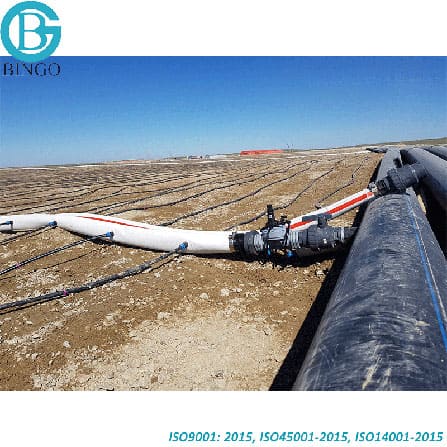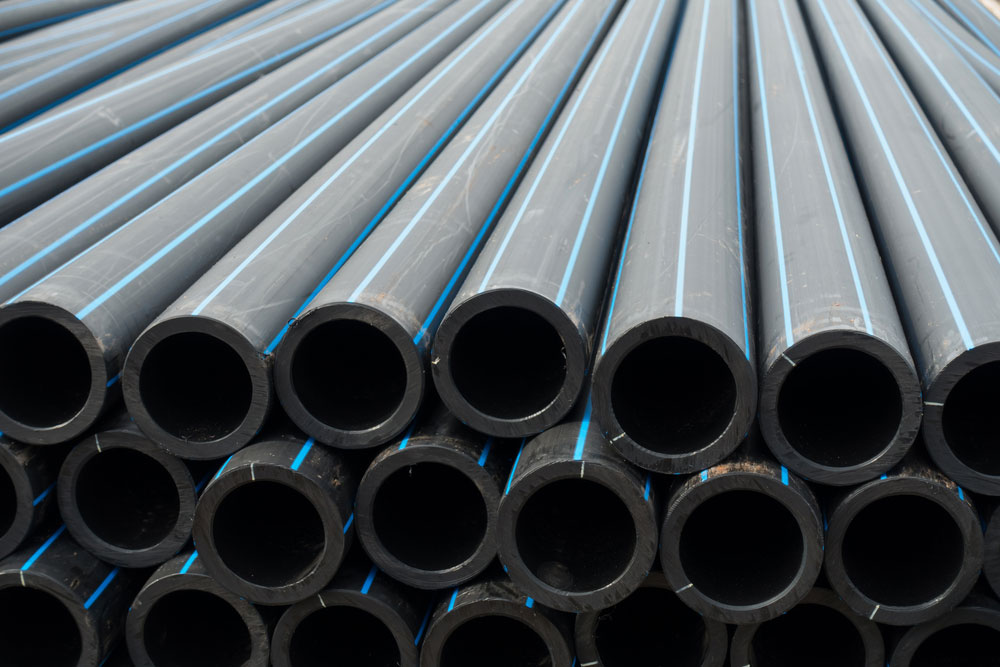Things to Know About Texas hdpe pipe manufacturer and What They Offer
Check Out the Production Refine Behind High-Quality HDPE Pipe and Its Applications
The production process of premium HDPE pipelines is complex and systematic. It starts with the option of raw materials that improve performance. Following this, ethylene undertakes polymerization to develop resin, which is then formed with extrusion. Quality assurance is extremely important, ensuring that the final item fulfills strict criteria. Nevertheless, the trip of HDPE pipes does not end with manufacturing. Their applications across various sectors expose a more comprehensive relevance worth checking out.
Understanding HDPE: Properties and Advantages

High-density polyethylene (HDPE) is a functional polycarbonate known for its durability and resistance to numerous ecological factors. This material shows exceptional tensile strength, making it suitable for requiring applications. Its low-density structure contributes to a light-weight item, assisting in simplicity of managing and installation. HDPE additionally showcases remarkable resistance to chemicals, which reduces degradation when subjected to rough materials.
The material's reduced wetness absorption further enhances its long life, making it optimal for use in pipes and tank. In addition, HDPE is immune to ultraviolet (UV) radiation, making sure that products maintain their integrity also when exposed to sunlight. In addition, its versatility permits the development of elaborate forms without jeopardizing toughness. The environmentally friendly nature of HDPE, usually obtained from recycled materials, includes in its appeal, promoting lasting techniques in manufacturing. On the whole, these homes and benefits make HDPE a recommended selection for various commercial and consumer applications.
Resources Option for HDPE Manufacturing
The selection of basic materials for HDPE production is important to confirm the last item fulfills the desired specs and high quality requirements. High-density polyethylene (HDPE) is mostly created from polymerized ethylene, obtained from nonrenewable fuel sources such as gas or petroleum. The top quality of these feedstocks significantly influences the mechanical and thermal buildings of the final HDPE.
Additives also play a substantial duty in enhancing HDPE's efficiency, including antioxidants, UV stabilizers, and colorants, which boost durability and resistance to ecological elements. The selection process must consider not only the chemical structure of the raw products but likewise their handling features to guarantee effective production.
The sourcing of raw products should prioritize sustainability and conformity with ecological policies, as accountable methods are imperative in today's market. Ultimately, careful resources choice lays the foundation for generating high-quality HDPE pipes ideal for diverse applications.
The Extrusion Process: Shaping HDPE Pipe
The extrusion process plays an important function in shaping HDPE pipelines, beginning with precise material prep work strategies that assure excellent flow and uniformity. Similarly essential is the style of the die, which directly influences the final measurements and surface area high quality of the pipeline. Together, these elements contribute significantly to the effectiveness and high quality of HDPE pipe production.
Product Prep Work Strategies
Reliable manufacturing of HDPE pipes starts with thorough material preparation methods, especially the extrusion procedure. Throughout this stage, high-density polyethylene resin is very first dried to remove dampness, guaranteeing ideal flow features. The material is then fed right into the extruder, where it undergoes home heating and melting, changing right into a thick state. This heating process is carefully managed to keep the material's integrity and efficiency. The liquified HDPE is compelled with a die, forming it into a continuous pipeline form. Correct temperature management throughout extrusion is crucial, as it straight affects the material's buildings and the end product high quality. Once shaped, the HDPE pipeline is cooled and reduced to specified sizes, ready for succeeding processing and applications.
Die Layout Value
Precision in die style plays a crucial function in the extrusion procedure of HDPE pipes. The die acts as the last shaping tool, directly affecting the pipe's measurements, wall thickness, and surface area finish. A properly designed die assurances uniform material circulation, decreasing defects such as abnormalities and weak points. The geometry of the die should be enhanced to accommodate the specific buildings of HDPE, including its viscosity and thermal habits throughout extrusion. Furthermore, the cooling rate of the material as it travels through the die can substantially impact the pipe's structural stability. As a result, spending in advanced die modern technology is crucial for suppliers aiming to generate top quality HDPE pipes that satisfy market criteria and consumer assumptions.
High Quality Control Actions in HDPE Production
Although various variables affect the top quality of HDPE pipeline production, reliable top quality control measures are crucial to ensure uniformity and reliability in the end product. Trick quality control methods consist of extensive material evaluation, validating that the raw polyethylene fulfills well-known standards for purity and thickness. Throughout the extrusion procedure, parameters such as temperature, pressure, and cooling time are closely checked to keep dimensional accuracy and structural stability
Additionally, post-production testing is important; producers usually perform hydrostatic tests to examine the pipeline's stamina and resistance to stress. Visual assessments for surface area flaws better enhance quality control. Certification from appropriate criteria companies, like ASTM or ISO, offers an additional layer of reputation. By implementing these extensive high quality control actions, makers can minimize defects, improve performance, and make certain that the HDPE pipes meet the details pvc bushing demands of different applications, ultimately bring about client complete satisfaction and depend on in the item.
Applications of HDPE Pipeline Throughout Industries
HDPE pipelines are made use of across different fields due to their toughness and flexibility. In water circulation systems, they ensure efficient delivery, while in wastewater administration, they give dependable services for waste transport. Additionally, farming irrigation networks take advantage of HDPE's resistance to rust and flexibility, making it a perfect selection for modern-day farming techniques.

Water Distribution Equipments
A substantial number of sectors rely upon high-density polyethylene (HDPE) pipes for effective water circulation systems. Recognized for their durability and resistance to rust, HDPE pipelines are commonly utilized in municipal water networks, agricultural watering, and industrial applications. Their light-weight nature helps with very easy handling and installation, decreasing labor costs and time. In addition, HDPE pipelines can fit numerous stress levels, making them ideal for both low and high-pressure systems. Texas hdpe pipe manufacturer. The adaptability of the product enables smooth integration into existing framework, minimizing the demand for considerable excavation. HDPE's resistance to chemical seeping guarantees that the water supplied remains risk-free and tidy, making it a perfect selection for keeping the high quality of safe and clean water across numerous sectors.
Wastewater Monitoring Solutions
Reliable water circulation systems likewise lead the way for innovative wastewater administration solutions, where high-density polyethylene (HDPE) pipelines play a substantial function. Prominent for their sturdiness and resistance to rust, HDPE pipelines are suitable for transferring wastewater in different setups. Their flexibility enables very easy installment in complex settings, reducing the demand for substantial excavation. In addition, you can look here HDPE's smooth indoor surface area lowers friction, improving circulation prices and efficiency. These pipes are also resistant to chemical leaching, ensuring that pollutants do not compromise the surrounding environment. Industries, communities, and treatment facilities progressively depend on HDPE pipes for their integrity and long life, making them a preferred choice for modern-day wastewater management systems. This versatility emphasizes the crucial value of HDPE pipes across various applications.
Agricultural Irrigation Networks
Agricultural watering networks profit substantially from using high-density polyethylene (HDPE) pipes, which give effective and trustworthy water distribution to crops. HDPE pipes are lightweight, making them easy to carry and install, while their adaptability enables various configurations in varied surfaces. These pipelines show excellent resistance to deterioration, chemicals, and UV radiation, ensuring longevity in rough agricultural atmospheres. Additionally, their smooth interior surface area lessens friction loss, enhancing water flow and minimizing energy costs related to pumping. The durability of HDPE pipes, usually exceeding half a century, contributes to reduce maintenance and replacement expenses. Subsequently, farmers significantly rely upon HDPE pipelines to enhance irrigation efficiency and advertise sustainable agricultural practices, ultimately bring about enhanced plant yields and resource conservation.
Future Patterns in HDPE Pipeline Technology
As the need for sustainable and reliable facilities grows, advancements in HDPE pipeline innovation are poised to transform various markets. Emerging fads include the integration of clever modern technologies, such as sensors and IoT capacities, which help with real-time tracking of pipeline problems, decreasing upkeep prices and preventing leaks. Furthermore, the advancement of sophisticated manufacturing methods, such as 3D printing, is allowing the production of facility, tailored pipe layouts that deal with specific task requirements.
The emphasis on recycling and round economic climate practices is driving the technology of HDPE pipes their explanation made from recycled materials, enhancing sustainability. Improved jointing methods, such as electro-fusion and mechanical installations, are likewise improving setup performance and reliability. Lastly, the growing emphasis on ecological policies is pressing suppliers to embrace greener production processes, ensuring that HDPE pipes not only satisfy market standards however likewise promote an even more sustainable future for infrastructure development.
Regularly Asked Inquiries
Exactly How Does HDPE Contrast to Various Other Plastic Products?
HDPE surpasses several other plastic materials regarding longevity, chemical resistance, and flexibility. Its reduced thickness and high tensile toughness make it perfect for different applications, often exceeding alternatives in both efficiency and longevity.
What Are the Environmental Impacts of HDPE Production?
The ecological impacts of HDPE production consist of greenhouse gas emissions, power consumption, and possible air pollution from manufacturing processes. Additionally, improper disposal can result in soil and water contamination, raising problems about long-lasting environmental results.
Can HDPE Pipeline Be Reused?
Yes, HDPE pipes can be recycled. Several centers accept used HDPE for processing, transforming it right into new products. This recycling contributes to sustainability efforts, reducing plastic waste while preserving resources and power in the manufacturing cycle.
What Is the Life Expectancy of HDPE Pipes?

How Do Temperature Variations Influence HDPE Pipe Efficiency?
Temperature level variants greatly influence HDPE pipeline efficiency, impacting flexibility and stamina. Heats can cause softening, while reduced temperature levels may create brittleness, ultimately affecting the pipe's sturdiness and viability for different applications in varied settings.